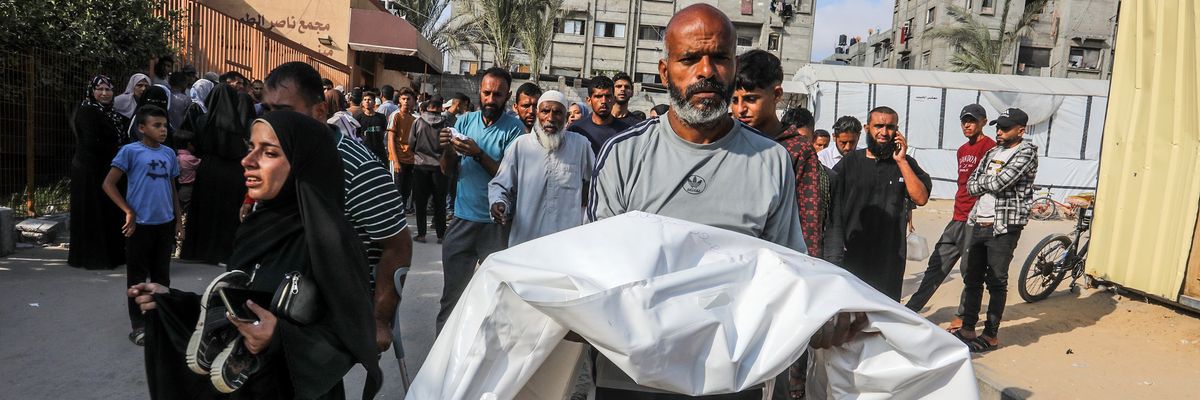Julia Conley
One
Palestinian man said he and his brother, who was killed, had no choice but to
try to access aid at privatized distribution points, even though they knew it
was dangerous to approach them.

With chaos and violence
persisting "by design" at aid sites set up by a U.S.- and
Israeli-backed organization in Gaza, the death toll at the distribution points
rose Wednesday, as did the overall number of deaths in the enclave since Israel
began bombarding the civilian population 20 months ago.
At least 120 Palestinians were
killed in the last 24 hours across the enclave, bringing the death toll in Gaza
to 55,104. Gaza's Health Ministry added that at least 474 people have been
injured over the past day.
The latest deaths include at
least 57 people who were seeking humanitarian aid, which Israel is allowing to
be accessed only at distribution points set up by the Gaza Humanitarian
Foundation (GHF)—staffed by U.S. security contractors and guarded by Israeli
forces. More than 363 people were also injured at aid sites by Israeli forces
since Wednesday morning.
In total, 224 people have been
killed at GHF's distribution centers since they began operating over the
objections of the United Nations, aid groups that have long worked in Gaza, and
an executive who had been leading the initiative but resigned late last month,
saying GHF's aid plan violated the "humanitarian principles of humanity,
neutrality, impartiality, and independence."
Issam Wahdan, a Palestinian man
whose brother was killed when he tried to retrieve aid near the Netzarim
Corridor this week, toldAl Jazeera that he and his brother had attempted to
obtain one of GHF's food boxes several times, "but we never got lucky."
"So, my brother and I
decided to go early to the distribution center," Wahdan told Al Jazeera.
"When we arrived, we were surprised to see quadcopters shooting at us. We
didn't know what to do, we had never experienced this before. The quadcopter
threw a bomb at us. There were many wounded and martyred people, including my
brother, who was wounded yesterday and died today. One of our best friends was
martyred on the spot."
Wahdan suggested he and his
brother saw the GHF distribution hubs as dangerous, but had to try to retrieve
aid to feed their families.
"We need humanitarian aid so
we have to go to the center. My brother was married and had two boys and one
daughter. His youngest is 18 months old," he said. "His children are
hungry and that forced him to go there to get some aid. When your children are
hungry, you need to do anything to provide them with food."
Israel has acknowledged firing
"warning shots" to control large crowds of starving Palestinians at
GHF sites, and have claimed that the Israel Defense Forces have shot only at
"suspects" who approached the troops. Israel and its allies have also
repeatedly claimed the IDF has been targeting Hamas in Gaza, even amid mounting
evidence that they have deliberately killed civilians.
Palestinians have been forced to
walk an average of 9.3 miles to retrieve boxes that Chris Newton, a senior
analyst with the International Crisis Group, said contain an amount of
sustenance that is "closer to the ration given in a starvation experiment
run in the 1940s in the U.S. than it is to Israel's own previous 2008 red line
for the minimum calories needed to avoid malnutrition in Gaza."
"The violence, the chaos,
and the complete inadequacy of the types and volume of aid being given out are
not so much mistakes of the system, but really by design," Newton told Al
Jazeera. "This is not the system you would design if your goal was to end
mass starvation in the Gaza Strip."
The GHF sites were established
more than 80 days after Israel imposed a total blockade on humanitarian aid in
March, just before it broke a temporary cease-fire. In May, the Integrated Food
Security Phase Classification released a report warning that the siege had
placed the entirety of the Gaza Strip in "Phase 4," with the
population suffering from "very high acute malnutrition and excess
mortality."
The United Nations Children's
Fund (UNICEF) on Wednesday posted on social media the story of a 5-year-old boy
named Osama, who was "once a healthy child in Gaza."
"He now weighs only 5
kilograms, dangerously below the healthy weight for his age. Osama is being
treated at Nasser Hospital but his full recovery depends on sufficient
nutrition and follow-up care—both of which are at risk," said UNICEF. "The
recovery of children like Osama is possible only with a long-lasting cease-fire
and aid at scale being allowed into Gaza."
Gaza's Government Media Office
said Wednesday that Israel is "deliberately creating chaos in the Gaza
Strip by perpetuating a policy of starvation and deliberately targeting and
killing starving people seeking food."
"This has been
achieved," said the office, "through direct, often intentional, and
sometimes random, killings by quadcopters, helicopters, or tanks, targeting
young men, elderly people, and children who rushed to obtain whatever food aid
was available to feed their children and families."

No comments:
Post a Comment